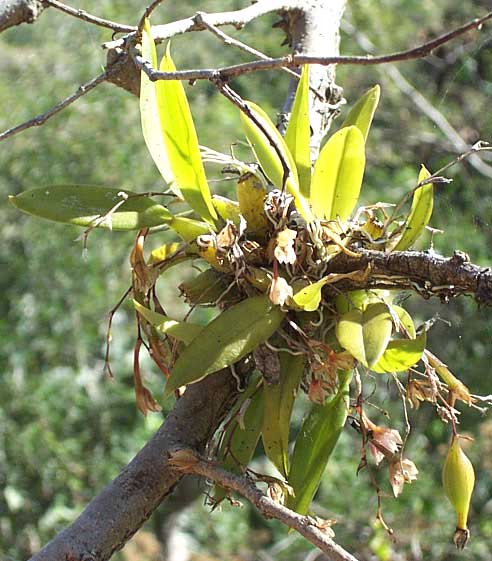Excerpts from Jim Conrad's
Naturalist Newsletter
from the January 26, 2007 Newsletter issued from Sierra Gorda Biosphere Reserve, QUERÉTARO, MÉXICO
ORCHID OUT ON A LIMB
Being so deep into the dry season, not much is blooming here other than the Sweet Acacias I told you about, and ornamentals planted and watered in people's yards. Still, the other day I was really tickled to find a cluster of epiphytic orchids growing on the completely leafless limbs of a tree next to the lake. You can see it below:

The plant was past its flowering peak, its few remaining white blossoms faded and drooped. Still, in the lower, right corner of the above picture it's nice to see one of the plant's fruits. Also, if you look closely you can see the white roots that are so helpful in distinguishing orchids from other epiphytes such as bromeliads and ferns. Finally, at the base of the left-most leaf you can see that the flat blade connects at an articulation point with a swollen, green, football-shaped item known as a pseudobulb. Pseudobulbs are storage organs for water and photosynthesized carbohydrate. Most orchid species don't have pseudobulbs, so these structures are very helpful in orchid identification. And that's good, since the Orchid Family is the largest of all flowering-plant families; distinguishing its ±20,000 species can be a challenge, especially when you're identifying wild species in a country without fieldguides.
Best I can figure out, this orchid is NIDEMA BOOTHII, fairly common but apparently with no common name. Pictures of plants with flowers at their peak can be seen on the Wikipeida page for Nidema.
My plants have stubbier-looking blades than the ones shown above, but I think that leaves on wild plants growing on exposed tree limbs in a dry scrub forest tend to be shorter and thicker than blades on plants pampered with mistings and grown in partial shade.
Nidema boothii is distributed from Mexico to Panama and also Cuba and Surinam. Its habitat is tropical moist forest and scrub up to 5000 feet in elevation. Blossoms at their peak are strongly fragrant, though my past-prime flowers were odorless. The whole plant was rather small, about the size of a teacup.